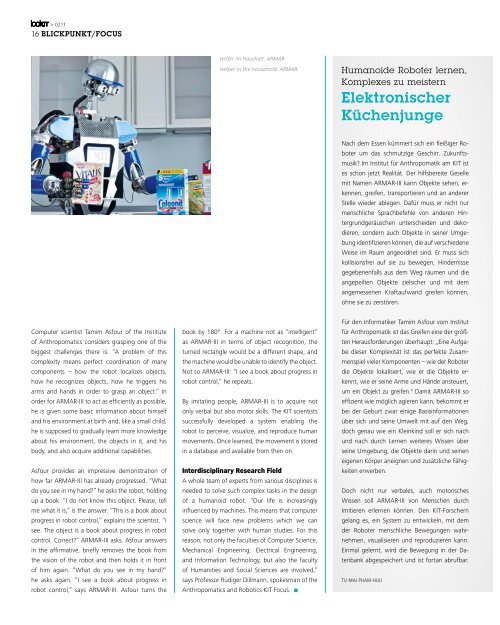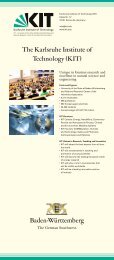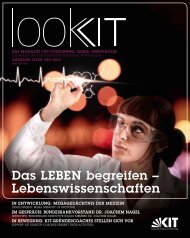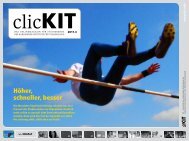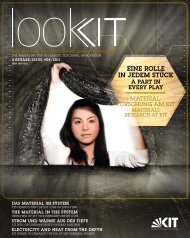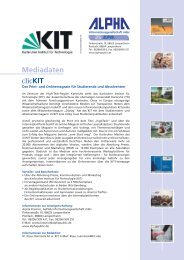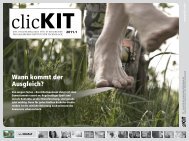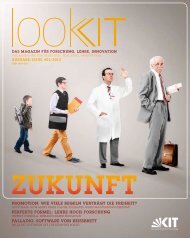lookKIT 02/2011 - PKM - KIT
lookKIT 02/2011 - PKM - KIT
lookKIT 02/2011 - PKM - KIT
Erfolgreiche ePaper selbst erstellen
Machen Sie aus Ihren PDF Publikationen ein blätterbares Flipbook mit unserer einzigartigen Google optimierten e-Paper Software.
<strong>02</strong>11<br />
16 blickpunkt/Focus<br />
Helfer im Haushalt: ARMAR.<br />
Helper in the household: ARMAR.<br />
Humanoide Roboter lernen,<br />
Komplexes zu meistern<br />
Elektronischer<br />
Küchenjunge<br />
Nach dem Essen kümmert sich ein fleißiger Roboter<br />
um das schmutzige Geschirr. Zukunftsmusik?<br />
Im Institut für Anthropomatik am <strong>KIT</strong> ist<br />
es schon jetzt Realität. Der hilfsbereite Geselle<br />
mit Namen ARMAR-III kann Objekte sehen, erkennen,<br />
greifen, transportieren und an anderer<br />
Stelle wieder ablegen. Dafür muss er nicht nur<br />
menschliche Sprachbefehle von anderen Hintergrundgeräuschen<br />
unterscheiden und dekodieren,<br />
sondern auch Objekte in seiner Umgebung<br />
identifizieren können, die auf verschiedene<br />
Weise im Raum angeordnet sind. Er muss sich<br />
kollisionsfrei auf sie zu bewegen, Hindernisse<br />
gegebenenfalls aus dem Weg räumen und die<br />
angepeilten Objekte zielsicher und mit dem<br />
angemessenen Kraftaufwand greifen können,<br />
ohne sie zu zerstören.<br />
Computer scientist Tamim Asfour of the Institute<br />
of Anthropomatics considers grasping one of the<br />
biggest challenges there is: “A problem of this<br />
complexity means perfect coordination of many<br />
components – how the robot localizes objects,<br />
how he recognizes objects, how he triggers his<br />
arms and hands in order to grasp an object.” In<br />
order for ARMAR-III to act as efficiently as possible,<br />
he is given some basic information about himself<br />
and his environment at birth and, like a small child,<br />
he is supposed to gradually learn more knowledge<br />
about his environment, the objects in it, and his<br />
body, and also acquire additional capabilities.<br />
Asfour provides an impressive demonstration of<br />
how far ARMAR-III has already progressed. “What<br />
do you see in my hand?” he asks the robot, holding<br />
up a book. “I do not know this object. Please, tell<br />
me what it is,” is the answer. “This is a book about<br />
progress in robot control,” explains the scientist. “I<br />
see. The object is a book about progress in robot<br />
control. Correct?” ARMAR-III asks. Asfour answers<br />
in the affirmative, briefly removes the book from<br />
the vision of the robot and then holds it in front<br />
of him again. “What do you see in my hand?”<br />
he asks again. “I see a book about progress in<br />
robot control,” says ARMAR-III. Asfour turns the<br />
book by 180°. For a machine not as “intelligent”<br />
as ARMAR-III in terms of object recognition, the<br />
turned rectangle would be a different shape, and<br />
the machine would be unable to identify the object.<br />
Not so ARMAR-III: “I see a book about progress in<br />
robot control,” he repeats.<br />
By imitating people, ARMAR-III is to acquire not<br />
only verbal but also motor skills. The <strong>KIT</strong> scientists<br />
successfully developed a system enabling the<br />
robot to perceive, visualize, and reproduce human<br />
movements. Once learned, the movement is stored<br />
in a database and available from then on.<br />
Interdisciplinary Research Field<br />
A whole team of experts from various disciplines is<br />
needed to solve such complex tasks in the design<br />
of a humanoid robot. “Our life is increasingly<br />
influenced by machines. This means that computer<br />
science will face new problems which we can<br />
solve only together with human studies. For this<br />
reason, not only the faculties of Computer Science,<br />
Mechanical Engineering, Electrical Engineering,<br />
and Information Technology, but also the faculty<br />
of Humanities and Social Sciences are involved,”<br />
says Professor Rüdiger Dillmann, spokesman of the<br />
Anthropomatics and Robotics <strong>KIT</strong> Focus.<br />
Für den Informatiker Tamim Asfour vom Institut<br />
für Anthropomatik ist das Greifen eine der größten<br />
Herausforderungen überhaupt: „Eine Aufgabe<br />
dieser Komplexität ist das perfekte Zusammenspiel<br />
vieler Komponenten – wie der Roboter<br />
die Objekte lokalisiert, wie er die Objekte erkennt,<br />
wie er seine Arme und Hände ansteuert,<br />
um ein Objekt zu greifen." Damit ARMAR-III so<br />
effizient wie möglich agieren kann, bekommt er<br />
bei der Geburt zwar einige Basisinformationen<br />
über sich und seine Umwelt mit auf den Weg,<br />
doch genau wie ein Kleinkind soll er sich nach<br />
und nach durch Lernen weiteres Wissen über<br />
seine Umgebung, die Objekte darin und seinen<br />
eigenen Körper aneignen und zusätzliche Fähigkeiten<br />
erwerben.<br />
Doch nicht nur verbales, auch motorisches<br />
Wissen soll ARMAR-III von Menschen durch<br />
Imitieren erlernen können. Den <strong>KIT</strong>-Forschern<br />
gelang es, ein System zu entwickeln, mit dem<br />
der Roboter menschliche Bewegungen wahrnehmen,<br />
visualisieren und reproduzieren kann.<br />
Einmal gelernt, wird die Bewegung in der Datenbank<br />
abgespeichert und ist fortan abrufbar.<br />
Tu-Mai Pham-Huu


